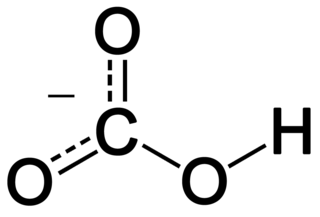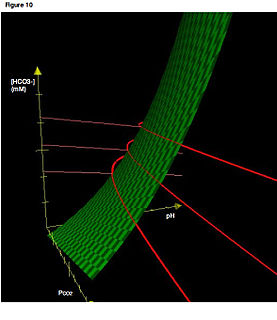This article needs additional citations for verification .(November 2013) (Learn how and when to remove this template message) |
| BMP/ELECTROLYTES: | |||
| Na+ = 140 | Cl− = 100 | BUN = 20 | / |
| Glu = 150 | |||
| K+ = 4 | CO2 = 22 | PCr = 1.0 | \ |
| ARTERIAL BLOOD GAS: | |||
| HCO3− = 24 | p a CO2 = 40 | p a O2 = 95 | pH = 7.40 |
| ALVEOLAR GAS: | |||
| p A CO2 = 36 | p A O2 = 105 | A-a g = 10 | |
| OTHER: | |||
| Ca = 9.5 | Mg2+ = 2.0 | PO4 = 1 | |
| CK = 55 | BE = −0.36 | AG = 16 | |
| SERUM OSMOLARITY/RENAL: | |||
| PMO = 300 | PCO = 295 | POG = 5 | BUN:Cr = 20 |
| URINALYSIS: | |||
| UNa+ = 80 | UCl− = 100 | UAG = 5 | FENa = 0.95 |
| UK+ = 25 | USG = 1.01 | UCr = 60 | UO = 800 |
| PROTEIN/GI/LIVER FUNCTION TESTS: | |||
| LDH = 100 | TP = 7.6 | AST = 25 | TBIL = 0.7 |
| ALP = 71 | Alb = 4.0 | ALT = 40 | BC = 0.5 |
| AST/ALT = 0.6 | BU = 0.2 | ||
| AF alb = 3.0 | SAAG = 1.0 | SOG = 60 | |
| CSF: | |||
| CSF alb = 30 | CSF glu = 60 | CSF/S alb = 7.5 | CSF/S glu = 0.4 |
Chloride is an anion in the human body needed for metabolism (the process of turning food into energy). [1] It also helps keep the body's acid-base balance. The amount of serum chloride is carefully controlled by the kidneys. [2]
The chloride ion is the anion Cl−. It is formed when the element chlorine gains an electron or when a compound such as hydrogen chloride is dissolved in water or other polar solvents. Chloride salts such as sodium chloride are often very soluble in water. It is an essential electrolyte located in all body fluids responsible for maintaining acid/base balance, transmitting nerve impulses and regulating fluid in and out of cells. Less frequently, the word chloride may also form part of the "common" name of chemical compounds in which one or more chlorine atoms are covalently bonded. For example, methyl chloride, with the standard name chloromethane is an organic compound with a covalent C−Cl bond in which the chlorine is not an anion.
Renal reabsorption of chloride (Cl−) is a part of renal physiology, in order not to lose too much chloride in the urine.
Chloride ions have important physiological roles. For instance, in the central nervous system, the inhibitory action of glycine and some of the action of GABA relies on the entry of Cl− into specific neurons. Also, the chloride-bicarbonate exchanger biological transport protein relies on the chloride ion to increase the blood's capacity of carbon dioxide, in the form of the bicarbonate ion; this is the mechanism underpinning the chloride shift occurring as the blood passes through oxygen-consuming capillary beds.

Physiology is the scientific study of the functions and mechanisms which work within a living system.

The central nervous system (CNS) is the part of the nervous system consisting of the brain and spinal cord. The central nervous system is so named because it integrates the received information and coordinates and influences the activity of all parts of the bodies of bilaterally symmetric animals—that is, all multicellular animals except sponges and radially symmetric animals such as jellyfish—and it contains the majority of the nervous system. Many consider the retina and the optic nerve, as well as the olfactory nerves and olfactory epithelium as parts of the CNS, synapsing directly on brain tissue without intermediate ganglia. As such, the olfactory epithelium is the only central nervous tissue in direct contact with the environment, which opens up for therapeutic treatments. The CNS is contained within the dorsal body cavity, with the brain housed in the cranial cavity and the spinal cord in the spinal canal. In vertebrates, the brain is protected by the skull, while the spinal cord is protected by the vertebrae. The brain and spinal cord are both enclosed in the meninges. In central nervous systems, the interneuronal space is filled with a large amount of supporting non-nervous cells called neuroglial cells.

Glycine (symbol Gly or G; ) is the amino acid that has a single hydrogen atom as its side chain. It is the simplest possible amino acid. The chemical formula of glycine is NH2‐CH2‐COOH. Glycine is one of the proteinogenic amino acids, and is notable as the only one that is achiral. It is encoded by all the codons starting with GG (GGU, GGC, GGA, GGG). Glycine is also known as a "helix breaker".
The normal blood reference range of chloride for adults in most labs is 96 to 106 milliequivalents (mEq) per liter. The normal range may vary slightly from lab to lab. Normal ranges are usually shown next to results in the lab report. A diagnostic test may use a chloridometer to determine the serum chloride level.
An equivalent is the amount of a substance that reacts with an arbitrary amount of another substance in a given chemical reaction. It is an archaic unit of measurement that was used in chemistry and the biological sciences in the era before researchers knew how to determine the chemical formula for a compound. The mass of an equivalent is called its equivalent weight.
A chloridometer is a measuring instrument used to determine the concentration of chloride ions (Cl–) in a solution. It uses a process known as coulometric titration or amperostatic coulometry, the accepted electrochemistry reference method to determine the concentration of chloride in biological fluids, including blood serum, blood plasma, urine, sweat, and cerebrospinal fluid. The coulometry process generates silver ions, which react with the chloride to form silver chloride (AgCl).
The North American Dietary Reference Intake recommends a daily intake of between 2300 and 3600 mg/day for 25-year-old males.
The Dietary Reference Intake (DRI) is a system of nutrition recommendations from the Institute of Medicine (IOM) of the National Academies. It was introduced in 1997 in order to broaden the existing guidelines known as Recommended Dietary Allowances. The DRI values differ from those used in nutrition labeling on food and dietary supplement products in the U.S. and Canada, which uses Reference Daily Intakes (RDIs) and Daily Values (%DV) which were based on outdated RDAs from 1968 but were updated as of 2016.








